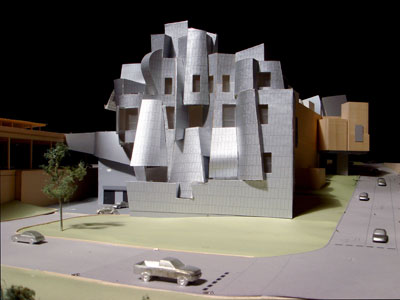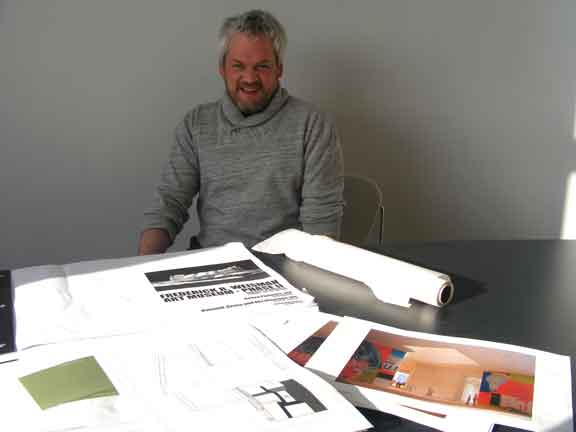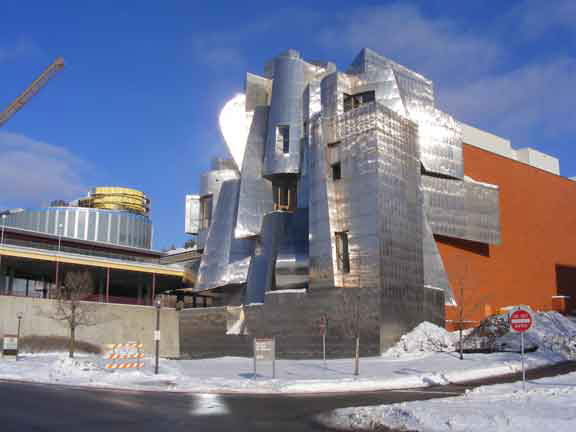Inside the Weisman’s $14 Million Expansion
Britt Aamodt talks with museum staffers and curators about the ambitious expansion (spearheaded by famed architect Frank Gehry) underway at the Weisman -- look for five new galleries and a revival of artist/community collaborations in the new space.




WHEN THE FREDERICK R. WEISMAN ART MUSEUM OPENED IN 1993, people took notice. Against the backdrop of formal university buildings, the Weisman exploded from its ledge overlooking the Mississippi in a sheath of steel and brick that stacked upwards in complicated geometric whimsy. No one had ever seen anything like it, certainly not on the University of Minnesota campus. But then, the Frank Gehry-designed building was always intended to awe, to excite response and lure people in the door; and it has done so for more than a decade.
So, when museum staff broke ground for a $14 million expansion* in late 2009, a host of questions surfaced. Who would design the expansion? What was going to be added, and how could the museum do so without losing the character and personality of the original architecture? Where on earth were they going to expand on an already cramped university campus? And, finally, what would such an expansion mean to the museum and the arts community?
Five New Galleries
The answer to every one of those questions begins and ends with Frank Gehry. The architect, 81 years old this February, was called upon to finish the project he began in 1991. “From the beginning we always knew we wanted to expand the Weisman,” says museum director and chief curator Lyndel King. “We couldn’t afford everything we wanted to build back then. So we cut back on gallery space, because we knew later on it would be easier to raise money for named galleries than for more behind-the-scenes spaces.”
In fact, a total of more than $14 million dollars* was raised for the expansion, with the goal of adding five galleries to the existing structure: four galleries to showcase the permanent collection and a fifth to highlight creative collaborations between artists and specialists in other fields. The new development will double the Weisman’s current exhibition space, which now runs around 11,500 square feet.
Having four galleries devoted to the permanent collection will allow the Weisman to air a good-sized chunk of its more than 17,000 items. Of course, “good-sized” is relative — at present, the Weisman only has space to exhibit a tiny fraction of its holdings, from 50 to 150 pieces at time, depending on the show.
“Right now, about one percent of our collection is on view,” says Christopher James, the museum’s communications and events director. “The two large galleries currently available are devoted to temporary and traveling exhibitions. So, the expansion will give us space to show off strengths in our collection. Two will be dedicated to American art, one to ceramics, and one to photography and works of art on paper.”
The four new galleries will attach to the eastern and southern sides of the existing structure. The addition will wrap around the southeast corner, in a cantilever arrangement, so that when you drive along the service road, which veers from East River Road, you’ll be driving underneath the new portion of the building. The fifth gallery, called the Target Studio for Creative Collaboration, will face the north side of campus; it will necessitate the removal and re-installation of the steel-skirted pedestrian bridge.
Creative collaborations
The Target Studio for Creative Collaboration was funded by a $2 million gift from Target, and will take advantage of the Weisman’s location at the University of Minnesota, which houses education and research in the largest number of disciplines in the country. “We’ll be inaugurating a new program of collaborations with the Target Studio,” says director King. “Being at a university allows us to bring together faculty, artists, and people from across the community to work on collaborative projects.”
Though exact details on those collaborations won’t be forthcoming until later, museum staffers are excited by the prospect of what they might do. “Artists from all over the country, all over the world, can come here,” James says. “And we’ll be able to facilitate collaborations between those artists with university faculty, grad students, and undergrads, and not necessarily just faculty and students from the arts.”
What might such collaboration look like? Consider a joint project by an artist who’s working with engineering and computer science faculty and students on robotics; or, a designer might join forces with medical school faculty on the design of a teaching lab. The possibilities for cross-pollination are endless. The Target Studio concept taps into an increasing desire to explore the relevance of art for disciplines and industries in the larger community. This sort of collaboration further encourages people to “think of art and design as something that can contribute to solutions. What can the mind of an artist or designer bring to researchers and the projects they’re working on?” says James.
________________________________________________________
The Weisman is expanding when the arts world (not to mention the world, in general) is coming to terms with the financial blows of the Great Recession. But the university’s art museum was born out of such circumstances, in the height of the Great Depression, so that “students would leave the university armed with values they’d need to be citizens in a pretty scary and challenging world.”
________________________________________________________
Why expand now?
Five years ago, the Weisman’s building committee met and began to talk over plans to expand the museum. The committee members were driven, in part, by a recognition that Frank Gehry was getting older. The Weisman would be a difficult building to add on to, they reasoned, and if anyone was to attempt the feat, that person should be the original architect.
“We’re absolutely thrilled that Frank has designed the expansion,” says Lyndel King, adding that the expansion will reveal the architect, not as he was in the 1990s, but as he is today. “He’s thinking differently about architecture now,” she says. A lot can change for an artist in seventeen years. For Gehry, those years have meant the design and building of the Guggenheim Museum in Bilbao, Spain; the Walt Disney Concert Hall in Los Angeles; the Jay Pritzker Music Pavilion in Chicago; and the IAC Building in New York City. And his architectural vision has evolved with every project.
“When you see the expansion, you’ll notice that it was designed by the same intelligence, but it won’t be seamless,” says King. “The building is as much a work of art as a work of architecture. And who but the original artist can change his work of art?”
The Weisman is expanding at a time when the arts world (not to mention the world, in general) is coming to terms with the financial blows of the Great Recession. The economic downturn is forcing arts organizations to tighten belts and rethink both short- and long-term strategies.
Surprisingly enough, the Weisman was born out of another such downturn, the Great Depression. Lotus Coffman, the fifth president of the University of Minnesota, served from 1920 until his death in 1938. During his time as university president, construction of Northrop Memorial Auditorium was green-lit. The auditorium provided a setting for concerts, convocations, and commencement ceremonies, and from 1936 to 1993, it also provided exhibition space for the University Art Gallery.
The University Art Gallery was Coffman’s idea. “He was president during the Great Depression, and he wanted to be sure students left the university armed with values they’d need to be citizens in a pretty scary and challenging world,” says James. “Coffman felt art was a way to instill those values. He was president, so, of course, he thought about the bottom line — but he also believed the arts were integral to the student experience.”
A new-and-improved Weisman and the broader arts community
The Weisman’s art collection isn’t as broad or deep as that of the Minneapolis Institute of Arts, nor is it as focused as the Walker Art Center’s. Frank Gehry’s space-age building often leads visitors to expect, primarily, contemporary art; and indeed, the Weisman has a significant collection of modern art, but the museum also owns sizeable collections of 12th-century ceramics and 19th-century Asian furniture. That eclecticism is what gives the museum its niche.
“I’ve always thought of the Weisman as your entry-level museum,” says King. “We can provide a beginning experience, but we can also offer sophisticated programs. The expansion means we’ll be able to provide visitors with the opportunity to have deeper relationships with our permanent collection, something you can only do when you see works of art many times.”
Apart from students, Minnesota artists comprise a significant audience for the museum. James figures that the proportion of visitors, between those on campus and those coming in from outside the U, is about half and half — and many of those museum-goers from the community are local artists.
“We’re lucky, because the Twin Cities has a particularly rich arts ecosystem,” says James. “Right now, we have a corridor for exhibits by local artists. Local artists and art historians can also use our art study room. Anyone can make an appointment to look at an object from our collection first-hand,” says James.
The Weisman’s physical expansion coincides with another ambitious endeavor: the museum is in year two of a three-year project to digitize their entire art collection. The result will be a virtual, searchable online museum, freed of space constraints and available from anywhere in the world. “You’ll be able to sort by medium, time period, and artist name. This will be revolutionary for the museum, in terms of making the collection available as a public research and learning tool,” says James.
To accommodate the building’s expansion, the Weisman Art Museum will close in the fall of 2010, with plans to reopen fall 2011. During that time, the Weisman staff plans to continue programming in off-site locations, possibly in other campus buildings.
________________________________________________________
About the author: Britt Aamodt‘s book on Minnesota’s contemporary cartoonists (Off Color) is coming out fall 2010 from the Minnesota Historical Society Press. Aamodt reports on the arts for KFAI radio in Minneapolis, and is the founder of the radio play group Deadbeats On the Air.
________________________________________________________
*Corrected 2/25/10: The original version of the article incorrectly offered $10 million as the cost of the expansion and amount raised by the campaign; that amount is actually $14 million.